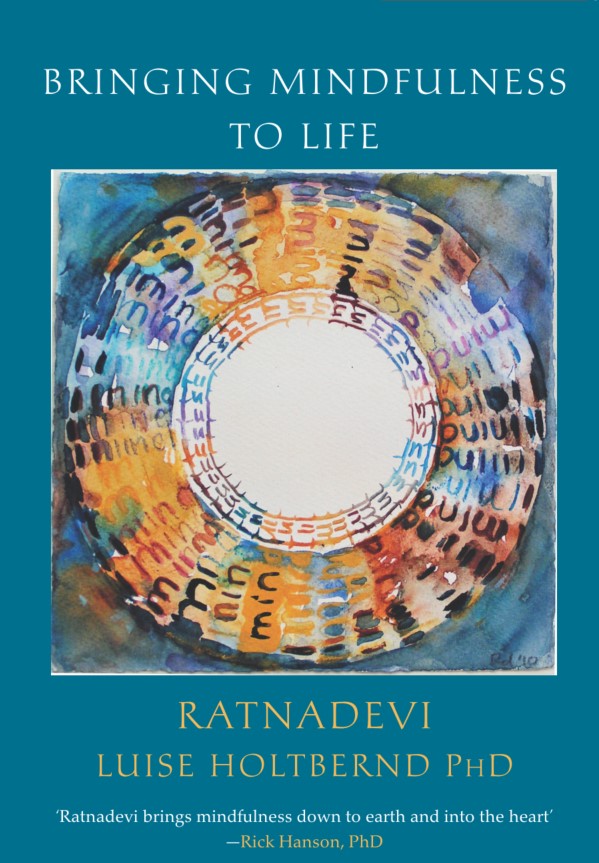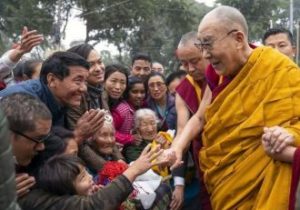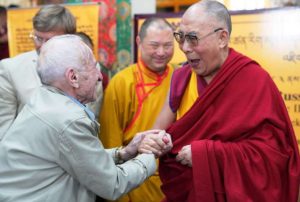
Too often, books and articles about mindfulness rest somewhere in the ether, filled with platitudes and foreign terminology. These may serve to inform or inspire, but quite often that inspiration is fleeting. The abstract and exalted states fade into oblivion as real life takes over. Ratnadevi’s new book Bringing Mindfulness to Life (PlaySpace Publications 2022) offers quite the opposite approach. This book gives us mindfulness from the ground up. We start with, and are constantly brought back to, what is real—this life in front of us.
The book, which is no lightweight at some 234 pages, covers all of the territory that a beginner or even intermediate student could hope to traverse. Advanced students of mindfulness, too, will take joy in Ratnadevi’s exquisite prose and delicate touch, often reflecting on the experiences of her young childhood that have shaped her right to the very moment of writing each page. Her approach is one of openness, drawing from her life as an ordained Buddhist as well as her training in mindfulness and her upbringing as a Catholic in Germany.
All of this is carefully crafted into a book that truly guides the reader through the realities of cultivating mindfulness. It is not a straight path. It often winds back to early memories—a loss here, an admonition there. The path runs headlong into modern life’s very real obstacles—how to deal with that bad haircut, buying a house, or navigating social media.
Every movement along the path is illuminated with a story. As Ratnadevi begins the book:
When I teach on mindfulness courses and on retreats, I notice the atmosphere in the room changing when I tell a story or read a poem. It could be an ancient parable from the Buddha’s times or the tale of that moment of mindlessness when I stumbled over an anchor chain on holiday and broke my ankle, a moment that led to discoveries about how to open to pain and still have a good time. It’s as if doors and windows open to let in a fresh breeze, carrying the scent of adventure, tragedy, kindness or mystery. My listeners’ eyes soften and their bodies lean forward a little: their whole being is involved, not just the thinking mind. Suddenly I am not the expert teacher so much as a fellow traveller traversing the landscape of shared human experience, pointing to certain marker stones that we all interpret in our own ways.
(13)
Ratnadevi’s stories disarm the reader as they draw us in. As she says, she becomes a fellow traveler. Of course, this is what we want in all of our guides in life. No one wants a doctor who knows everything before even discussing your symptoms, or a mountain guide who claims to know exactly how best to reach the top without a sign of awareness of changing weather conditions.
As we travel, we want a guide who knows the way well, based on past experience. But we also want to know that they are open to whatever may come in the path ahead. Who knows, what comes up may be totally new to both of you. And this is the feeling the reader gets in moving through the pages of this book. Clearly, Ratnadevi has a path planned out. We start with setting our intentions, a fundamental step in traditional meditation practice. From there we sort of meander, from what I can tell in no particular order, through a host of practices and reflections on the path. That meandering, though, is always firmly grounded in the vicissitudes of contemporary life. It is a book by an author who walks the walk, so to speak, not just someone who has merely studied the material.

As such, this is more than a book about mindfulness. It is a book about this moment in time, seen through realistic yet hopeful eyes. Nowhere is this clearer than in her chapter on “Engaged Mindfulness,” in which Ratnadevi writes: “It is not easy for anyone to know how to live with full awareness in these difficult and confusing times. It can bring up a mixture of despair and outrage, the urge to do something and the doubt that anything will be enough.” (132–3) Ratnadevi shares with us her feelings of guilt and complicity, knowing that her food choices affect farmers and laborers in far-flung parts of the world, and that so much of what we buy is made up of or coated in plastics that will eventually make their way to the ocean and, worse yet, into our bodies and into the bodies of children even before they are born.
Ratnadevi also draws fluently from the great voices of our day—from Joanna Macy and Rebecca Solnit to Rick Hansen and Jon Kabat-Zinn. Through her writing, these great women and men remind us of both the urgency of our practice and the joy in pausing to savor this beautiful life. As dire as our global situation may be and as traumatized or confused as we may feel, there is always the possibility of a return to now, to mindfulness. This is the gift, for many of us, of Buddhism as a religion, which we have been born into or have adopted. And it is also the gift of mindfulness as it is being spread around the world with care and compassion.
While you can find monthly gems of presence in Ratnadevi’s column, Bringing Mindfulness to Life, here at BDG, readers will benefit from the realness of the physical book of the same name as its pages invite preparation, practice, and reflection on mindfulness as a universally available human quality.
See more
Bringing Mindfulness to Life (PlaySpace Publications)
Bringing Mindfulness to Life (BDG)
Related features from BDG
Mindful Christmas!
Secular or spiritual? Reflections on Roots and Values in Mindfulness, Buddhism, and Beyond
Book Review: Mindfulness: Where it Comes From and What it Means
Cleaning the Fridge: Getting Off Autopilot
Loving your Tick: Book Review of Mindfulness as Medicine
The Problem of Plastic and Being Complicit
Overcoming Obstacles to Mindfulness Practice












